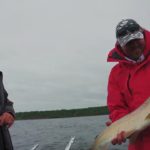Vertical Holds And Time-out-of-water: Critical Issues in the Handling and Release of Trophy-sized Esox by Michael Butler
 A long-standing debate among catch and release anglers of Esox involves the merits of horizontal holds versus vertical holds for the traditional pre-release photograph. Those favoring the vertical hold correctly state that in the scientific literature, there is no documentation of harm associated with hanging a large esocid intended for release, vertically by the jaw or operculum (gill plate).
A long-standing debate among catch and release anglers of Esox involves the merits of horizontal holds versus vertical holds for the traditional pre-release photograph. Those favoring the vertical hold correctly state that in the scientific literature, there is no documentation of harm associated with hanging a large esocid intended for release, vertically by the jaw or operculum (gill plate).
Do fish handled in this manner suffer a greater likelihood of injury or delayed mortality?
Decades ago, as a student of fish anatomy, I thought the answer was a matter of common sense. The narrow symphysis connecting the lower mandibles seemed poorly designed to withstand the shearing force of a heavy, struggling pike or muskellunge. It also seemed that hanging a big fish vertically from a single hand under the operculum could injure vital tissues associated with respiration and feeding. The alternative of holding a large fish horizontally and providing support from two hands just seemed like common sense. A few years ago, I was getting so many questions about this from anglers that I set out to see just how common this sense was.
First, I solicited comments from researchers who routinely handled big muskies or pike. Among them were: Bernard Lebeau, Ed Crossman, Terry Margenau, Rod Ramsell, Bob Strand, Steve LaPan, and Arunas Liskauskas. Specifically, I asked these and other experts to comment on the risk of injury to larger (25 pounds or more) fish arising from being vertically suspended from the jaw.
While each of the muskellunge management professionals drew from a unique set of experiences, all were outspoken in recommending against the single-handed, vertical suspension of larger fish, as they felt this increased the likelihood of mechanical injury to the fish. Some-Rod Ramsell, Minnesota Department of Natural Resources, and Steve LaPan, New York State Department of Environmental Conservation-provided accounts of injuries or delayed mortality for muskellunge subjected to this kind of handling. As well, all emphasized minimizing out-of-water time, and some, a well-supported horizontal hold, if a photograph was necessary.
I should add that whenever the subject of best release practices came up in conversation with Dr. Crossman, he invariably cited an article, The Muskie Stress Factor, written by Muskies, Inc. member Rich Zebleckis, published in Muskie Magazine (Vol. 20, No. 9, pp. 11-12, 1986). The piece included a questionnaire and a scoring system that enabled the reader to assess the potential stress associated with each component (fight duration, de-hooking, handling time and methods, number and style of hooks, etc) of the catch and release process. Dr. Crossman appreciated the effective manner in which the article conveyed the ideas that (1) the stresses incurred by a fish through the C & R experience are additive, and (2), like the manner chosen to hold the fish, these individual stressors are largely under the control of the angler.
My enquiry’s didn’t end with the North American Esox specialists. I posed the same question to dozens of marine biologists, fish physiologists and biomechanical engineers. These are folks who know much better than I do just what makes a big fish tick, and what might constitute mishandling. Some were authorities on gill mechanics, while others were experts on the physical properties of different tissue types. Of great relevance was the experience of the marine biologists who, as a group, had captured, tagged and released hundreds of thousands of large saltwater fishes on several continents.
Scientists are busy people. I would have been satisfied if only a third of those I wrote took the time to respond. Surprisingly, all responded, many with the view that they thought the subject was important. Some chose to comment on additional stressors, but this diverse group of scientists was unanimous in the view that the vertical hold (again of a 25-pound plus fish) by the jaw presents a much greater chance of injury to the fish. Many comments converged on the risk of injury to the fragile structures around the gills. Consistently, the muskie handlers and salt-water fish trackers were advocates of using a sling/stretcher/cradle type of device to control fish and maintain a horizontal orientation.
In the time since I polled my colleagues for their views of how best to handle Esox for catch and release, I became familiar with the recent work of our own Upper Great Lakes Management Unit of the Ontario Ministry of Natural Resources, under the direction of Arunas Liskauskas. After nearly 10 years of conducting spring spawning surveys involving the trapnetting, spawn-taking and biological sampling of medium to very large muskellunge (many fish over 50 lbs) on Lake Huron, the fisheries crews have developed considerable expertise in handling big fish. They have learned to restrain, weigh, measure, transfer, and sample fish only while they are being held horizontally in a cradle. For much of the processing, the cradle is immersed. I learned quite a bit from their experience, and I have modified my own DNA sampling protocol to conform to theirs to reduce stress and the risk of mortality to the muskellunge I handle.
I should emphasize here that the experts I consulted are not opponents of killing fish. To the contrary, the physiologists routinely sacrifice fish or apply invasive surgical procedures to their study subjects. Most of the natural resource biologists are hunters and anglers. Thus, all are members of one or more groups who have themselves been targeted by the animal-rights fringe. Their views are grounded in science and experience, not sentimentality.
 Taking the responses from this diverse group as a whole, I wasn’t left with the view that all fish held vertically invariably die as a consequence, but rather, that the risk of injury is much greater. This is a very significant management issue for low-density, naturally sustained trophy fisheries in Canada. Most of our World Record Class waters are characterized by having low numbers of long-lived, slow growing females distributed over vast areas of habitat. Consider Georgian Bay or Lac Seul, as examples. A seemingly small increase, say 2 percent, in annual angling mortality may result in a very significant decrease in recruitment, erosion of potential trophy production, and the decline of the stock. In the current Ontario fishing regulations, as well as pamphlets co-published by the Ontario Ministry of Natural Resources and Muskies Canada, vertical holds of muskellunge are strongly discouraged.
Taking the responses from this diverse group as a whole, I wasn’t left with the view that all fish held vertically invariably die as a consequence, but rather, that the risk of injury is much greater. This is a very significant management issue for low-density, naturally sustained trophy fisheries in Canada. Most of our World Record Class waters are characterized by having low numbers of long-lived, slow growing females distributed over vast areas of habitat. Consider Georgian Bay or Lac Seul, as examples. A seemingly small increase, say 2 percent, in annual angling mortality may result in a very significant decrease in recruitment, erosion of potential trophy production, and the decline of the stock. In the current Ontario fishing regulations, as well as pamphlets co-published by the Ontario Ministry of Natural Resources and Muskies Canada, vertical holds of muskellunge are strongly discouraged.
While the physiological determinants of delayed mortality in muskellunge have been the subject of very little research, the study of other species has valuable lessons for muskie anglers. Researchers from Dr. Bruce Tufts’ lab at Queen’s University have studied the blood chemistry associated with stress and delayed mortality for angled salmonids, walleye and bass. In all cases, out-of-water time has been identified as the most significant human-caused stressor. This has led to modifications of the weigh-in procedures in a growing number of Ontario bass tournaments. Bass are weighed in a column of water thus eliminating air exposure and reducing the weighing time from 30 to 5 seconds in a process that’s now ‘hands-off.’ Very clever!
If we consider the data for other species, it’s reasonable to suppose that air exposure may be the single greatest cause of post-release mortality in muskellunge. I strongly encourage muskie anglers who haven’t already done so to consider foregoing the out-of-water photo session for all but ‘personal bests,’ particularly during warm water conditions or when red, blood-engorged fins indicate heightened physiological stress. After an exhausted fish has been removed from the water for even a few quick photographs, it usually takes minutes for it to regain physical equilibrium and minutes more to swim down through the water column. Make no mistake-this is an acutely stressed animal. These are the fish that are most likely to not recover from acute blood acidosis. Now, contrast this scenario with that of the fish played quickly to the boat and spared any out-of-water handling. These fish tend to recover their faculties in moments. If you’re skeptical, try it out for a half a dozen fish next season. You’ll be amazed at the difference in the condition of the fish.
Recognizing that some anglers will continue to want to remove trophy class fish from the water for photographs, a few of the researchers I canvassed suggested that during the preferred horizontal hold, contact between the fish and dry surfaces (hands, arms and clothing) should be minimized, otherwise protective mucous or "slime" could be removed. They recommended avoiding the "hug shot" where the fish is held against the chest inside the forearms, favoring instead two pre-wetted hands being the only points of contact between angler and fish.
Conclusions
Do we need a "controlled study to assess the effects of vertical holds" as advocated by a dwindling number of vertical hold proponents? In my grandfather’s fishing prime, it was normal practice to pick up a pike or muskie by inserting a thumb and a forefinger into the eye sockets. The diminished use of the "eye socket hold" didn’t follow a controlled study, legislation, or the will of an animal rights lobby. It was discarded by a new generation of conscientious, conservation-minded anglers who applied common sense to reach the conclusion that picking up fish by the eye sockets cannot be good for the fish. I believe the same ethic and intelligence is driving the trend of reducing out-of-water time and the avoidance of hanging of large fish vertically from the operculum or jaw. As for the call by vertical hold practitioners for a "controlled study," my discussions with the scientists left me certain that none of them would consider conducting such a study when the anatomy, behavior and physiology of fish-all known factors-so strongly suggest that a brief horizontal hold, or no air time at all, are the least injurious options.
It is clear that a growing number of anglers, and industry professionals, understand that our fisheries will benefit from catch and release only if it’s practiced effectively. We all make choices that affect the chances of post-release survival. My discussions with experts in the fields of muskellunge research, marine fish biology, fish physiology and biomechanical engineering caused me to reflect upon-and alter-my own muskie handling techniques, both as an angler and a scientist. I hope you will consider their views, not as a rationale for criticizing others, but as food for thought as you evaluate your own handling methods and approaches to muskie conservation.
*Michael Butler is devoted muskie angler and a Ph.D. candidate at Trent University. He works out of the DNA laboratory of the Aquatic Biodiversity and Conservation Unit of the Ontario Ministry of Natural Resources. Michael is applying DNA markers to questions associated with the evolution, management and ecology of muskellunge, and other members of the pike family. He can be contacted at [email protected]
What the Muskellunge Researchers Say:
Steve LaPan, New York State Department of Environmental Conservation
As you know, there are no studies out there to evaluate post-handling survival using different release techniques. During our trap net/radiotelemetry studies, we found large, adult muskellunge to be extremely sensitive to stress. Accordingly, we handle all adult muskellunge in a "stretcher." I have been an outspoken opponent of holding adult muskellunge vertically for any length of time. This is based on finding dead, tagged muskellunge subsequent to receiving letters with photos from anglers who had caught and released the fish after holding them vertically. Obviously this is anecdotal, as we don’t know other circumstances associated with the "fight" and landing of the fish. A muskie’s body was designed to be supported in water, and I believe that there is internal injury inflicted on the fish when it is taken from the water and held vertically.
I like to err on the conservative side. Landing nets cause problems, but are in my mind much better than gaffs. There are landing nets made with a rubber-like material which seem to be a better choice than regular knotted nylon. Cutting hooks with side-cutters makes the release process faster, and hopefully less painful (with less blood loss) for the angler. We advocate use of the "muskie stretcher", knowing well the problems associated with trying to use one.
Terry Margenau, Wisconsin Department of Natural Resources
Obviously the horizontal hold is more logical. If it is of any value, my personal procedure for handling muskellunge caught by angling is as follows:
1. Net the fish at boatside and keep fish in the water as you drift to shore. Most of the time in WI you are not too far from shore when a fish is caught.
2. Remove hooks and transfer fish into cradle. I think the cradle offers a great inlake livewell for fish while gear is untangled and you get ready for photos if needed.
3. If photos are taken the fish can be easily lifted horizontally several inches to a foot above the water for a picture. If the fish struggles, it can be lowered back into the cradle for the next try.
Dr. Robert Werner, State University of New York, College of Environmental Science and Forestry
In our work with muskellunge we have used a sling and more recently a bag which we slip the fish into before we take it out of the water. This provides considerable support for the fish and prevents all of the potential problems [associated with handling fish]. Holding the fish by the gill cover or jaw is a very damaging thing to do to such a large fish. Most guides in the St. Lawrence are taking precautions when landing fish. They either have a sling of their own or they try, as much as possible, to release the fish without taking it out of the water.
What the Bioengineers and Fish Physiologists Say:
Dr. Peter Aerts University of Antwerp, Belgium
I know this ‘vertical hold’, and I have always thought this could not be a very good thing for the fish! Indeed, since fishes are evolved to perform in a medium where support of body weight is of no importance, I guess that the spine is not really built to withstand large tensile forces. Apart from this, however, I also think about potential damage at the level of the head. The operculum is a delicate structure of high importance for respiration and feeding. It is operated by a series of small muscles near its joint with the suspensorium (just where the weight is supported in vertical holding!) and it forms part of an important mechanical linkage involved in jaw opening. I can thus imagine that any damage done to the opercular system (including the branchiostegal membrane) influence (at least temporarily) the respiratory and feeding performance, which must have in turn an impact on the general condition of the specimen.
Dr. John G. New, Loyola University Chicago
Extreme care has to be taken in handling it to provide adequate support for the body, and holding a large fish vertically by its jaw is almost certain to cause serious internal injury. And to claim that large fish like muskies routinely survive this sort of treatment is probably wrong. To take the "angler’s eye" view and say that the fish swam away from the boat looking fine is not saying much. It can take hours or days for internal hemorrhaging to kill a fish. The fisherman doesn’t see the damage done, but serious internal bleeding, combined with the stress of fighting and landing, can quite easily kill a large fish slowly over time. My basis for making this claim is almost twenty years of experience in handling medium to large fishes in scientific research. All I am trying to say is that if you plan to release a fish to fight another day, be sure to provide adequate support (ideally a cradle) for the fish’s body to prevent damage to the internal organs and mesenteries, which are far more fragile in aquatic animals than in terrestrial ones.
Dr, David Coughlin, Professor of Biology, Widener University, Chester, PA
I don’t believe spinal cord or internal organ damage would be the greatest concern. Instead, I would be more concerned about damage to the connective tissue of head and to the gills. The jaws are certainly not constructed to have the body hung from them. I believe the horizontal hold is much safer position in that context.
Dr. Joseph D Zydlewski, University of Massachusetts
I would tend to agree that the vertical hold of a fish is more damaging than that of a "cradle" approach. I would expect that much of the damage is in the strain brought on the gill cover, however, rather than the internal organs. Stretching of the spine may also occur, but I have seen tears at the operculum in even relatively small fishes (less than 5 lbs).
Dr. Elizabeth L. Brainerd, University of Massachusetts
It certainly seems to me that holding a fish by the operculum (or lower jaw, as I have also seen for smaller fishes) would stretch and possibly tear muscles that are used for respiration and feeding. However, supporting the body with another hand would disturb the mucus coat of the body in that area. Overall, I would say that supporting the body as much as possible is a good idea.
What Scientists Who Handle Other Large Fishes Say:
David Welch, Fisheries Researcher, James Cook University, Australia
The barramundi (Lates calcarifer) recreational fishery is quite big in Northern Australia and very often the fish are released after capture (and a photo). These fish grow to over 20kg and so anglers endeavour to handle these fish carefully to minimize harm. Almost all anglers use the horizontal method. I have handled fish of all sizes for tag and release and always avoided picking them up by the gills as much as possible.
Dr. Colin Attwood, Sea Fisheries Research Institute, Roggebaai, South Africa
I run a tag and release project from the surf along the south coast of South Africa. We tag approximately 2500 fish per year, of 15 different species. Some of these get very large. The method we have developed, and that I recommend to all anglers in South Africa who return fish, is to make a stretcher of some strong plastic or non-absorbent canvas as long as the longest fish one can reasonably hope to catch, and wide enough such that it equals the girth of such a fish.
We have tagged fish up to 55 kg using this method, and it is rare for a practised angler to keep the fish out of the water [for very long]. Small fish can be tagged, measured and released under a minute. If barbless hooks are used, no pressure need be exerted on the fish to remove the hook. Other than that, it should not be necessary to handle the fish, unless of course the fish misbehaves badly, which is rare for large fish, and can be drastically reduced by folding the stretcher so as to keep the fish’s eyes out of direct sunlight.
Photographs of the fish are also improved by the stretcher, as the fish posture is more natural. Of course the angler does not get his face next to the fish, but if he is serious about release, it should not matter. Fish can also be weighed in the stretcher. We don’t do this (to save handing time), unless the mass is specifically required for some research purpose.
We have had satisfactory recoveries of all species that we have tagged. The stretcher has been used from sandy and rocky shores and from boats. The latter is more difficult, depending on the amount of freeboard and the size of the waves, but practice makes perfect.
My advice to anglers who hold the fish up vertically by the gills is to eat it.
Dr. Sabine Wintner, Natal Sharks Board, South Africa
In my work with anglers during tag and release tournaments (beach fishing) I have come across similar problems you describe . In my opinion holding the fish horizontally is definitely preferable to holding it in the operculum. I will not tag fish that have been carried through the water in such way. Damage to gill filaments, mandibles etc. is far likely to be higher than injuries due to holding it horizontally. The only problem I have seen with the horizontal method is that some fish have a protective "slime layer" which then ends up at the anglers clothing. This, however, is probably better than dragging the fish in the sand…
Alf Hogan Senior Fisheries Biologist, Department of Primary Industries and Fisheries, Australia
In the mid eighties, I was working on the hatchery technology of barramundi. We wanted to produce fingerlings for stocking impoundments. My job included catching the broodstock. We angled 50 brood sized fish, weighed them by the jaw as we and our grandfathers had done, then watched the lot die over the next 10 days, despite antibiotic injections. Bloody frustrating!! I initially suspected the anaesthetic, so went out and collected another lot of fish of all sizes, and used a different anaesthetic. Again, there were a lot of deaths, but all the fish under 3kg survived. Obviously survival was related to weight. The next lot of 6 fish of 6-15kg were all weighed in a sling, and all survived.
We do know from experience that the vertebrae separate, because we sometimes hear and feel a cracking noise similar to knuckles on fingers being "cracked." I have actually measured a 35mm increase in length of a 930mm fish held vertically. We have also seen damage to the throats of fish.
We still have doubters over here, because anglers see released fish happily swim away. I am fairly friendly with the leading angling writers here, and managed to convince them and the magazine editors at the time to not publish photos of fish held vertically. It didn’t take too long, so for at least 10 years, we haven’t seen a photo of a fish held vertically. Please note that "tailing" fish, i.e., lifting by the tail wrist (caudal peduncle) is just as damaging, perhaps even more so, than lifting by the jaw.





